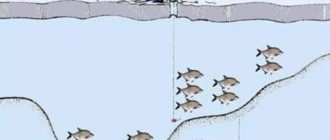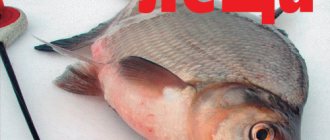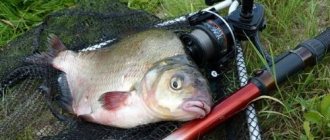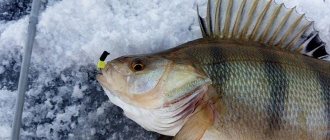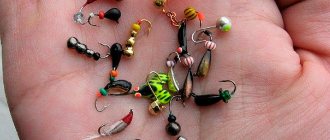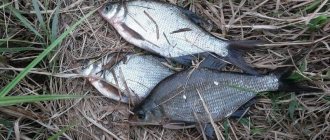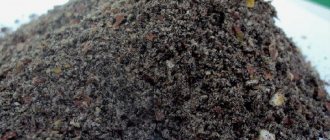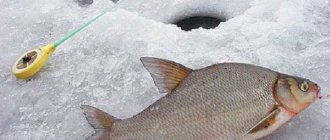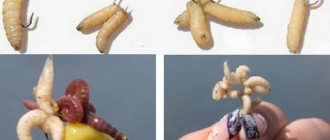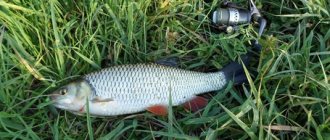It is traditionally believed that lazy, clumsy bream in winter indifferently lets through a bait that moves too actively. In this regard, most anglers catch this fish with bait on fixedly installed float or nod fishing rods. True, there are enthusiasts who are always on the lookout, constantly moving across the ice of a reservoir, looking for places where bream camps, but in the vast majority of cases they also fish with a jig with the addition of bloodworms. And only a very small category of fishermen practice catching bream with a reelless reel in winter. Very often these innovators come up with a good catch at a time when it seems that the fish are not feeding at all.
Catching bream with a reelless reel in winter
It is quite difficult to explain this relationship between bream and an oscillating jig. Obviously, during periods of low activity, the fish watches the bait for a long time before touching it with its lips. It detects the discrepancy between the vibrations of the bloodworm on the jig and the natural movements of the larva and moves away from it. In the case of a baitless jig, bream and other fish, not seeing the discrepancy between the artificial and the living, react only to the vibrations created by the jig, which it picks up with all sensory organs.
In general, deciding to switch to catching bream with a baitless jig is quite difficult. Many people, having started to master it, quickly lose interest in it, since finding the right game is not so easy. If the bream and white bream do not find themselves biting at all (and they do not take any bait), then the beginner, having caught a little with a nozzle jig, quickly returns to the jig with the addition of bloodworms - after all, this is a proven method. Practice shows that no more than 7 percent of the entire army of fishermen catch fish with a baitless jig.
In order to consistently catch bream and bream using a baitless jig, you should carefully select all the elements of the equipment and balance them properly. It is equally important to improve your skills: correct playing technique is the basis for success. Searching for catchable places also plays an important role. Let's start in order.
Catching bream with a reelless jig
For many winter fishermen, large bream is still the number one target of hunting. Of course, this is not a pike perch or a pike, but fishing out a large “shovel” from a decent depth, and even in a strong current, is a great pleasure.
Recently, bream fishermen have begun to catch quite effectively bream and large white bream using a reelless jig. But until recently, this catchy bait was treated rather dismissively. They say that this simple bait is good only for unpretentious perch.
And give the bream a baited jig, and even a tricky retrieve. Now the fishing community has shared opinions. Someone has become an ardent supporter of baitless bream fishing. Someone did not fully appreciate its capabilities - he tried it and returned to the usual classic jig attachment.
For a completely green beginner and an experienced angler who is accustomed to fishing with attached jigs, it is better to start mastering the reelless fishing with the classics. It is not advisable to go straight to the bulky “goats”, “bolds”, “devils”, “witches”, since the learning process with relatively small “Urals”, “nymphs”, “ants”, and dreisennas will be much easier and faster.
Large, cautious bream are always distrustful of bright, shiny baitless baits. A small bream may still peck at them, but if its larger brother takes it, it will be sporadically, and the bites will often be random.
It is better to use dark, matte jigs with various combinations of inserts - non-ferrous metal plates.
jig shapes
Catchable beads for catching bream in winter
A very important element of any baitless jig for bream is a set of beads mounted on the shank of the hook.
These, at first glance, completely stupid trinkets add a special flavor to any mothless item. It is thanks to the different color combinations of beads that the jig turns into a highly specialized bait.
If you attach beads with a combination of black and orange colors to the bend of the hook of the same bait, then the reelless bait turns into a perch bait, and it will be taken mainly by small stripers.
See also: Where to fish on the first ice and what is better? Sharing my experience
But if you change the beads to a white-blue combination, the bait becomes bream, and large white bream and full-sized bream will take on it.
If you don’t have beads of a suitable color on hand, then small cambrics from wire insulation, similar colors to the beads, will also work. The hook itself of a cool nozzle should not be too large and elongated.
Playing a reelless jig for bream
As for the game, the Internet and various fishing magazines often indicate the need for a uniform rise of the jig at a certain frequency and amplitude of oscillations. It cannot be denied that the rise can give a certain percentage of additional bites, but it is secondary, sometimes it is of no use at all, and sometimes it is simply harmful when a large bream takes in a very narrow horizon, which happens quite often.
When a school is found (it can stand either at the bottom or a meter above), it is better to start fishing without any ascent or descent at all. The essence of the game when catching bream is that the jig does not move vertically or horizontally, but vibrates strictly in place. This is an effective technique, and much easier to learn, compared to when the same game is played with a rise.
The main thing is that the oscillations are stable, and there are at least three of them per second (from 180 per minute). The more fluctuations, the more bites, but at the same time there is a higher chance of failures, which lead to a lack of bite. It turns out that it is more profitable to shake a maximum of 200 per minute than to malfunction at a higher frequency.
See also: Corn as fishing bait
nods for winter fishing
The second important point in the game of a reelless jig: a good game depends not so much on the hand placed, but on a good nod, which, by and large, plays itself, and the main thing is not to interfere with it. Experienced fishermen use various nods for fishing, from flat metal plates to all kinds of synthetic tubes.
If the material itself does not lose elasticity in the cold, then any material will do. It is only necessary that it be elastic, so that it can really set the necessary bream game. The deflection under the weight of the jig should be no more than 1-1.5 cm from the horizontal.
And the third important nuance is what the output should be. Oscillations are created by the six on the section of the nod closest to it. The head of the nod itself (from where the line goes to the jig) trembles at a high frequency, but the amplitude is minimal - it practically plays on the spot.
If the deviation of the nodding head is more than 1 mm, then the game will not be important. Moreover, this means not only vertical deviations, but also horizontal ones, which are even more harmful. This means that you need to continue to train hard, honing your playing technique, or try a nod to bream from a different material.
Bait of bream. When catching bream with no bait, it is a good idea to use complementary foods. In winter, there is no need to be too clever; regular bloodworms are suitable as complementary food. But in order to prevent small ruffs and perches from completely destroying it before the bream school approaches, it is advisable to freeze the larvae before fishing and drop them into the hole in small pinches.
There is no need to treat the rewinder one-sidedly. After all, this is a fairly universal bait. And if it is known that the bream is standing under the hole, but takes it sluggishly and inactively, then to activate the bite, you need to attach bloodworms or maggots to the hook without a bait, having previously darkened the holes with snow or ice crumbs, since this fish is wary of the light falling on the water in winter. This simple technique often brings excellent results.
Source
Winter tackle for bream
Rigging a winter fishing rod for bream
Rod
For a novice fisherman, the best choice is a fishing rod 40–45 cm long with a comfortable (preferably cork) handle (5 to 15 cm long) and an open or closed reel with a spool diameter of 4.5–6 cm. The reel brake can be blind or frictional. The latter is much more convenient when fishing at various depths, especially in relatively shallow water, where bream can go during a thaw.
The whip is set 20–30 cm long. In general, the type of fishing rod is determined by the wiring technique and fishing conditions. Some successfully fish with a balalaika, others use homemade models, others prefer branded Finnish fishing rods.
Nod
This is one of the most important equipment elements. It can be made from various materials. The best choice for catching bream with a no-attachment jig is a conical nod made from a clock spring; You can use propylene, polycarbonate, Mylar tape or other soft material.
The length of the nod can reach 18 cm. Such dimensions allow you to achieve stable play and even out unnecessary, unexpected movements of the hand. When using small jigs in shallow water, the length of the nod is maximized.
Shortened nods are used in windy weather and when fishing at a depth of over 5 meters. Under various fishing conditions, short nods made from a gramophone plate work well. The nod must have an end hole or ring for passing the fishing line. On long nods, in order to prevent sagging of the line, crimp cambrics are installed or an additional hole is made in the middle of the nod.
Fishing line for bream in winter
It is best to use soft modifications with a diameter of 0.1–0.15 mm such as “TEKLON” (Japan) or “SILYER FISH” (Germany).
These lines, having increased knot strength and a very smooth surface, are less susceptible to tangling when fishing near frozen ice chips. For fishing at depths of more than 7 m, hard fishing lines are used. This is due to the fact that a rigid line sinks faster, gets tangled less when landing fish and transmits a bite more clearly. We can recommend sinking fishing lines.
This is interesting: Selecting a high-quality ice screw
The quality of the game depends on how thin the fishing line is. However, it should be borne in mind that large bream should not be caught on fishing lines with a diameter of less than 0.1 mm, since there will inevitably be breaks.
It makes no sense to use thinner but stronger “braids” in winter conditions only because they will freeze even in mild frost.
Jig for bream in winter
For reelless fishing for bream, most anglers use “devils”. This type of jig came into fashion in the seventies of the last century. There are many modifications of these baits, they are sometimes very different from each other, their appearance is largely determined by the imagination of the manufacturer.
“Devils” may vary in body shape, method of attaching hooks and fishing line, shape of hooks, method of adding beads or other artificial additions, etc. Wiring options may also vary depending on the model.
The most common “devil” has a triple hook, but even four-hook models are often used. Some experimenters use two “devils” at once. This is due to the possibility of provoking the fish to intercept, because with two baits it appears that one aquatic organism is chasing another.
Practice has shown that with a good bite, it is preferable to use a large “devil”, which can reduce the percentage of large fish hatching. It is known that ovoid “devils” are less hooky than elongated ones. Recently, “devils”, which are made in the form of segmental joints, have become popular.
This is interesting: You can drill with a screwdriver
The choice of bait color is usually determined by its similarity with the colors of aquatic invertebrates. The most commonly used colors are black, gray, and dark brown. Depending on the characteristics of the reservoir, lighting and other fishing conditions, sometimes yellowish, greenish baits or those that have a combined color are used. But there are exceptions in the form of burgundy and other colors.
In case of fishing at great depths, of course, heavy tungsten “devils” with sharply sharpened hooks will be preferable. Their color may be somewhat lighter than that of baits used in shallow water, where it is best to use jigs of a dark, matte, black-brown color.
The option of an elongated nozzle jig with hooks soldered into a lead or tungsten body is considered optimal. There is also a hook attachment on a movable suspension. The size of hooks for catching bream is No. 10–13, for bream – No. 13–18.
Not so long ago, fishermen came up with the idea of using all sorts of artificial additives in combination with a baitless jig. The question arises: what to take as a bait for the “devil” intended for catching bream? Just as there are many artificial materials, there are also many options for their fastening or installation. Beads, seed beads, polystyrene foam, foam rubber, elastic band, thread. It’s impossible to list everything, but there are some generally accepted options for artificial attachments that give good results. The most popular among fishermen are beads that move freely on the hook.
Read also: Catch bream on a river or reservoir in winter?!
The combination of white and yellow beads attracts large bream well. Sometimes it is enough to put a yellow or ivory bead on the hook. You can attach a tiny piece of dirty red or yellow foam rubber to one hook. A combination of white and yellow cambric is also suitable. It should be remembered that the combination of white and red colors attracts perch, and if you put a white foam ball on the hook, then there may be no end to the bleak.
Sometimes when fishing for bream and bream, a positive result is obtained by putting one or two yellow beads (beads) directly on the fishing line, which, when reeled, tap against each other and against the body of the bait. The acoustic signals produced in this case apparently remind bream of the sounds emanating from small aquatic organisms at the moment when they are actively moving.
Continuing the conversation about the no-attach jig for bream, we note that in addition to “devils”, fishermen widely use single-hook “nymphs”, “uralkas”, “ants” and double-hook “goats”. These jigs are also most often used in combination with beads placed on a hook.
It is the beads that, with certain vibrations of the nod, create a unique effect of a vibration field, which the fish perceives as a signal to start feeding.
In general, a nozzle-free jig can be positioned in relation to the fishing line either vertically or at an angle of 120 degrees. The location of the jig is largely determined by its modification and the method of fixing the fishing line (Fig. 125).
Like “devils,” some models of jigs may have a hinged connection between the hook and the body of the bait, which helps create additional non-standard vibrations. This brings success when fishing in those reservoirs that experience strong fishing pressure. Of course, here too there should be some artificial addition on the hook in the form of colored beads, tiny cambrics, foam particles, etc.
As for the color of the hooks, practice has proven that in any lighting conditions, wary bream are more bold in taking the bait from a dark rather than a light hook. For baitless fishing, you need to take hooks with a shallower hook, which is well camouflaged with beads or other artificial bait.
Reelless bream
The reelless jig, as a highly sporting and exciting method of fishing, is winning more and more convinced supporters, gradually displacing traditional equipment for ice fishing.
During the open water season, from early spring to late autumn, almost all types of fish are caught using a reelless bait - from perch to carp, and bream and crucian carp are caught no less often than using jigs with bloodworms or maggots attached. But closer to winter, the sites and migration routes of cyprinids change, strikingly different from those to which we are accustomed in the summer. Long before freeze-up, the coastal zone is occupied by the ubiquitous perch and bream, and roach and bream go to the depths, to their “winter quarters.” The carp bite near the shore practically stops. The explanation for this is simple: aquatic life, which, by the way, is imitated by the reelless jig, by the time the first ice forms, moves from shallow waters to depth. Shortly after the first frost, bream appears in the same place, appearing in shallow water areas less and less often, only during periods of short thaws, occasionally pampering anglers with bites. After the first frosts hit and the reservoirs are covered with a durable ice shell, a fertile time comes for searching for schools of bream on “hard water” with a reelless jig. As a rule, at the beginning of winter, bream remains active: its bite is practically no different from the summer one, at times turning into a real glutton. The main thing that is now required of the fisherman is to find a feeding school of bream.
Fishing tactics
Search is the key word when fishing for bream. It makes no sense to hatch it in one feeding place during the first ice period, since the fish moves throughout the entire reservoir. It is better to start searching for bream from the maximum depths - there is the greatest probability of finding it; It is at a depth of 8–14 m that a trophy specimen can be caught. Although more often bites occur at the very bottom, sometimes bream and bream stand quite high, rising above the bottom up to 1.5–2 meters, and sometimes higher, so it is necessary to check all horizons of the probable presence of fish. To speed up the process, you can use an echo sounder, although there is an opinion that the beam of an echo sounder can alert the bream, and in general, when searching for fish with modern electronics, a certain mystery of biting is lost. But sometimes you can’t do without an echo sounder. At the end of last season, our fishing team came to the Petrokamensky city pond for bream, which we had successfully caught here the day before. After spending an hour running around yesterday's holes and not seeing even a hint of a bite, we decided to go to the car parked on the shore to get an echo sounder. And what happened? The bream stood at half-water, rising 3 m from the bottom. He just stood there, practically motionless. A miracle did not happen, we never saw a bite... but at least we saw the reason for its absence. I must say that I use an echo sounder extremely rarely, exclusively on unfamiliar bodies of water to study the bottom topography and search for likely sites for winter pike perch and bream in order to save time. A winter day, alas, is short, and you don’t want to waste it. As the ice thickens, the bream becomes more and more inclined to a sedentary lifestyle, staying in certain places, most often on feeding holes, so it is advisable to catch it there. The tactic consists of a systematic examination of the holes where they were caught with bait the day before. To open fresh, recently frozen holes, it is convenient to use a light pick or a spoon-type ice drill. It is advisable to open several nearby holes at once, and then fish them one by one. Of course, we must not forget about fishing ethics and it is advisable to fish in your own holes, or at least not to occupy other people’s holes without permission. Having found a “cool” hole, you need to take care of it and not try to catch all the fish from there at once. As soon as the bites become too cautious, you need to give the hole a rest for a while, moving to another. To activate the bite, you can periodically throw a pinch or two of bloodworms directly into the hole, if the depth is not very deep and there is no noticeable current. For the same purpose, it is good to use a miniature feeder, hooking it directly to the hook of the jig in order to control the horizon of its emptying. It is better to do this a couple of meters from the bottom. In the spring, the bream comes to life again and begins to actively move around the reservoir in search of food, so you should not linger on the old feeding holes, you need to drill more and more new ones, as at the beginning of winter. Of course, this is more difficult than on the first ice, but it is completely justified.
Mormyshka
What kind of jig is needed to successfully catch bream for the game? The most common bream jig is, of course, the devil and its various variations, including those with hanging, triple and single hooks. The optimal hook size for a bream devil tee is No. 14–16, dark in color, made of thin wire and always sharp, with a small beard. It is better to make it yourself; factory tees are usually worse. Hooks should be chosen with a straight hook. When purposefully catching large bream, you don’t have to go small with the body size of the jig and the hooks themselves. The main condition is that the bait looks appetizing. For the same reason, a tungsten devil is not at all necessary, since the weight of a large lead body is quite enough to feel the play of a jig well at a depth of many meters. In addition, when using jigs that are too miniature, the number of trips increases, especially when catching large fish, after which the bite in the working hole may stop. In the vast majority of cases I use imps made from pure lead or tin-lead alloy. It often happens that it is the tin devil who brings good luck. What is the reason for this? I believe that the action of a light bait is smoother and its behavior in the water is more natural. Although at extremely great depths (10 m or more) you can’t do without tungsten jigs. Along with the devil, good results when catching bream are obtained by using “uralok”, “ants” and “nymphs”. Such jigs, from 3 to 10 mm long, are usually painted black, less often green or brown. Sometimes jigs the color of tarnished copper and bronze turn out to be catchy. Just under no circumstances should you polish them! The playing technique is practically no different from the playing technique of the devil, but still it is, as a rule, more active. It is useful to change jigs periodically, as the bream gets used to monotonous movements and the type of bait and stops reacting to it. It seems that there are no fish here, but as soon as you replace the jig, the bite resumes. What can be said about the shape and color of devils, as well as other bream-less jigs? It is necessary to experiment, having with you a supply of different-sized and multi-colored baits. But the most common, universal, if you like, classic, option is a slightly elongated black cone with a red woolen thread wound 3-4 turns around the forend of the tee near the devil’s body. It is quite enough to have several classic devils of different weights and a clearly balanced jig-nod system.
Nod
A good, sensitive nod is extremely important for the correct play of a reelless jig. Usually it is made of a metal springy conical plate and has a length of up to 250 mm, always with the ability to adjust for precise adjustment to the weight of the jig. Lavsan nods, like polypropylene ones, are not very suitable due to their low elasticity. In recent years, carbon fiber nods have become increasingly popular. To make carbon nods, sections of telescopic rods and aircraft model slats of suitable size and thickness are used. Carbon fiber nods are easily cut with scissors and processed with sandpaper; they can quickly be given any desired shape. Carbon nods are distinguished by soft play and good sensitivity. Perhaps their only drawback is the inability to give the carbon plate the desired bend, which is easily achieved when using metal nods. Well, when making such nods, you need to work in rubber gloves so as not to get your hands splintered. As for which nod is better - metal or carbon, single-cone or double-cone, I will say this: let the seeker find. There is no place for dogma in fishing; the only key to success is constant search and experimentation. Of great importance is the ability of the nod to impart a barely noticeable play to the bait, the so-called “trembling”, when the nod plays at the base and is practically motionless at the top. Although it is believed that when catching bream with a devil, a fast game with a small amplitude is not needed, it happens that such a game brings success.
Equipment
Bream is a fairly large fish and requires a certain margin of safety in the tackle.
A fishing line with a diameter of 0.11–0.14 mm is quite suitable; there is no need to use a thinner one. The main thing is that the bait, under its weight, can pull the line into a straight line, hence two more requirements for the line - softness and lack of memory. When using an excessively thick or stiff fishing line, there is a mismatch, a dissonance, so to speak, in the “sounding” of the “nod-jig” tandem; vibrations of the nod are eaten up by the “accordion” from the fishing line, and the greater the depth of fishing, the stronger this effect. If for some reason it is necessary to use such a fishing line, as a last resort, although I am not a supporter of this when catching large bream, you can weight the equipment with a second bait by making a tandem of two devils or other reelless jigs. Although it is undesirable to use a tandem when purposefully catching large bream due to the high probability of the free jig getting caught on the edge of the ice, in some cases this is the only way to feel how the bait plays. Tandem or "steam locomotive". This is the name for a combination of two (and sometimes more) jigs, one of which is attached to a fishing line, usually 15–30 cm higher than the other. Usually it is a combination of two devils or goats. Although other types of jigs work well in tandem - from “Uralka” to “banana”. Tandem makes it easier to find fish, as it attracts them from a greater distance. Using a tandem, you can quickly find the working horizon if the fish is at half-water. This is especially important when fishing at great depths. Tandems, as a rule, are more catchy than single jigs, since, obviously, they awaken in the fish a desire to get ahead of a competitor or punish for impudence. In addition, the tandem creates the illusion of a large amount of food in one place, which works akin to bait. As a rule, the lower jig in tandem is larger than the upper one. A special case of a tandem is the so-called “suspension”. Suspension. Instead of a jig, a hook with beads, cambric, a strip of rubber, etc., freely moving along the fishing line or rigidly attached to it, is used as the upper element. Often inactive fish prefer such a suspension to a larger jig. As a stopper for the suspension, you can use a ready-made rubber stopper for match equipment, sold in sets of several pieces, or ordinary small beads, secured with a fishing line passed through it several times or wedged with a sliver of a match or a toothpick. The distance between the stoppers is usually 10–20 cm to allow free movement of the pendant. Whether or not to use a tandem is decided individually, for a specific fishing trip. If the goal is trophy hunting, then using a tandem is not advisable, but in other cases - why not?! I usually always have a pair of fishing rods equipped with tandems with me. And they rarely stand idle without work.
A game
When they talk about the catchiness of one or another representative of a huge family of all kinds of devils, witches and goats, this statement is often based solely on the personal experience of the narrator.
It happened that a bait that worked great for a fisherman I knew, so to speak, did not fire for me. Each angler without a reeler has his own techniques developed over the years of practice, which are not always suitable for someone else - everyone has different hands, a different style of play, and, in the end, a different physical form. Some people fish while sitting on a box, some from their knees, and some from both sides. Some are in a tent, while others are exclusively in the fresh air. For example, I most often fish by squatting at the hole. It’s so comfortable and familiar to me, and my quickly numb legs don’t allow me to sit in one place - involuntarily, after 5-7 minutes you get up and move to another hole. You have to spend time exploring each hole, but if a working hole is found, the time spent searching will be more than compensated by a rich catch. I have repeatedly observed that slightly different fish are caught in different positions of the body, for example, sitting - bream, and from the knee - bream. Yes, this is understandable - the game is different, albeit a little, but still... Therefore, if there is no bite, it is sometimes useful to change your position, and to warm up at the same time. Many newcomers to reelless fishing try to understand its secrets by watching experienced “devils” and imitating their style of playing with a jig. This shouldn’t be done: there is no one killer game, everyone brings something of their own, unique to them. The only thing you need to pay attention to and adhere to if possible is the monotony of the wiring. This applies exclusively to bream; other fish, such as roach or perch, are not so scrupulous. As soon as a malfunction occurs in the uniform movements of the devil or other reelless bait, it is useless to continue wiring - the bream is unlikely to take it. It is better to lower the jig to the bottom and try to repeat the wiring, avoiding falsehood in the game. There are many options for playing with a nozzle jig. I will give the most common ones. “Saw” - the fishing rod creates reciprocating movements in the horizontal plane, as when working with an imaginary saw. At the same time, slowly raise the fishing rod up from the hole. You can “saw” at different speeds and frequencies. This technique is most used by “devils”. At the end of the retrieve it is useful to pause and hook. Often there is a fish on the hook, following the jig, but not daring to grab it. “Spiral” - slowly draw circles in a horizontal plane with a fishing rod, smoothly lifting it. As a result, the trajectory of the tip of the fishing rod has the appearance of a spiral. When playing this way, the fishing rod is held vertically, with the whip lowered to the hole itself. “Swinging” is smooth vibrations with a large amplitude and low frequency, both when raising and lowering the jig. This technique works very well at the very bottom. In general, it is useful to start the very first stroke when checking the hole with a smooth, sweeping swing. “Dribbling” is small high-frequency oscillations with a small amplitude, in which a kind of wave travels along the nod. “Shaking” is the same as dribbling, but with greater amplitude. “Smooth rise” is a slow rise of the jig from the bottom. There is no game as such with this method. “Smooth lowering” follows after the above transactions. Under no circumstances should you suddenly drop the jig to the bottom; this can take away the fish’s appetite for a long time. “Wiggle” - oddly enough, it is often this simple technique that brings good luck if the bream is passive. The jig sinks to the bottom and, as it were, swarms there without rising higher. All of the above techniques can and should be alternated, choosing the most effective combination at the moment. The bite on a mothless baitfish is often weak. It seems as if the line got caught on the ice for a split second or there was a subtle glitch in the game. The hook should follow immediately. Although decisive bends and rises of the nod when fishing for the same devil or goat are not uncommon, especially at the beginning of winter. When initially fishing a hole, it is better to make the wiring as high as possible. In the morning and before lunch, it makes sense to find a bream site and fish without using bait, but after the working hole is depleted, you can feed it with a small amount of bloodworms or jigs. After three to four hours of the day, you should stop drilling new holes and return to the previously fed ones. Towards evening, bream and bream usually rise after the bait, and the bites follow a meter or two above the bottom, so the retrieve should start from the bottom and end as high as possible.
Fishing rod
A great variety of fishing rods have been invented for reelless fishing, but most of them have one thing in common - a reel.
It is the reel that allows you to quickly wind and unwind the line when moving from hole to hole, and also makes it possible to give up the line when the fish jerks or an excessively sharp hook. For the last few years, I have been using Finnish Teho fishing rods with a large-diameter open reel for both jig fishing with a bait and for reelless fishing. These fishing rods are very convenient for fishing with a jig: the reel allows you to quickly reel in the fishing line without a spiral forming on it, the sector friction brake protects the fishing line from breaking during a sharp hook, and the brake button is conveniently located. I take 9 of these fishing rods with me: with a line of 0.12 mm - 3 pcs., one of them with fluorocarbon, 0.11 mm - 2 pcs., 0.14 mm - 2 pcs., 0.09 mm - 2 pcs. . This set allows you to quickly adapt to fishing conditions. A big plus is the unified removable whips of different lengths and elasticity, equipped with non-removable plate nods made of beryllium bronze and a clock spring, also sprung by a clock spring. The “ski” spring, as if continuing the whip, serves several purposes: 1. Prevents excessive bending of the nod and allows you to achieve higher amplitude play. 2. Within certain limits, adjusts the rigidity of the nod. 3. Prevents the nod from turning along the round whip, fixing the nod in a certain position. 4. Makes it easier to adjust the nod (sliding metal on metal is easier) in winter water conditions. On any of my fishing rods you can quickly change the whip assembly with the nod. Since I hold the fishing rod with the handle up and play it like a pendulum, the nods are strongly bent upward, at an angle of 120–130°, the hook is made by moving the forearm. Pros: stable play without glitches, instant hooking due to the small angle between the nod axis and the fishing line. The only thing I did was to change the handle on a couple of fishing rods to a cork handle (made of cork crumbs on epoxy), a little longer and thicker than the standard one made of EVA for convenience and comfort, since I usually fish without gloves. Although Teho fishing rods come with cork handles, the standard ones are too thin and short for my hand. I carry whips in special tubes made from the elbow of an old telescopic Volzhanka to protect the stationary nods from damage, which, when traveling, are folded (shifted) along the whip and secured with a cambric. There is only one drawback of this scheme - it is necessary to tie the jig each time before starting fishing, which is compensated by confidence in the quality of the fresh knot and the selection of the optimal jig for the conditions of a particular reservoir. There is a variant of the Teho fishing rod with a plastic pencil case handle, hollow inside and plugged at the end with a red stopper. The thin handle looks poor and inharmonious, but the design is solid and, most importantly, the handle is the right length. I slightly modernized a couple of these: I pulled a 4 mm thick neoprene black shell (from a children’s dumbbell) onto the handle, having previously placed a rubber retaining ring made from a plumbing gasket of a suitable diameter in front of the brake button to prevent the neoprene “shirt” from slipping. The stopper is fixed in a ring groove, as if specially designed for it. It immediately became more convenient: the hand does not freeze, it is comfortable to hold and the aesthetics are at its best. The grip is possible both direct and reverse. For tandem fishing, I use simple-design fishing rods with a non-removable whip and a screw clamp on the reel drum. The nods on them are also non-removable with a spring, like on Teho fishing rods. All of the above fishing rods have an open reel, which, during transitions from hole to hole, allows you to wind the line over the spool, like on a reel, without changing the length of the line, which is convenient for controlling the difference in depth. Having arrived at the place, we drop the jig into the hole, while the line comes off the spool, like from a spinning reel, easily and freely. To be fair, it should be noted that some reelers use a fishing rod without a reel, such as a “shcherbakovka” or similar designs, but these did not take root for me for a number of reasons, the main one being the lack of mobility.
Epilogue
In conclusion, I want to say that catching bream with a reelless jig is only possible during daylight hours. At night, bream prefers to take motionless food lying on the bottom. I have repeatedly tried to disprove this rule, but most often to no avail. I’ll tell you about the specifics of night bream fishing in the next article. Happy fishing!
On a note
If the bite is over, this does not always mean that the bream has left or stopped feeding. It has been noticed that the fish get used to the bait and its action, and therefore replacing the jig can contribute to the resumption of the bite. If the goal is trophy hunting, it is not advisable to use a tandem. One of the baits can get caught on the lower edge of the ice, which in most cases leads to the fish leaving. The material was published in the December 2013 issue
Technique for catching bream using a reelless reel
There are general principles of the game that you should pay attention to. The main thing in the game is to make the jig only vibrate, practically remaining in place. At the same time, it is permissible to carry out a measured rise of the bait from the bottom by 30 cm - 40 cm - 50 cm - up to 1 m.
The vibration of the jig is achieved by methodically constantly rocking the fishing rod with a significant frequency and small amplitude of the nod oscillations. If the oscillations of its tip are not close to zero and there are also glitches in the game, this does not attract, but rather scares away the fish.
They begin wiring after the bait sinks to the bottom. After tapping the jig on the ground several times, they begin its subtle rise upward, imparting to the bait no more than 120 vibrations per minute. This can be done slowly, gradually increasing the lifting speed depending on the bites that occur or do not occur.
Advice! Typically, most bites occur at the bottom when the jig is torn off from it or when the jig is lowered onto it.
There are specific ways of playing, one of which is “sawing” with the line resting on the edge of the hole. This eliminates glitches in the game. The vibration frequency of the jig in this case can be very minimal, sometimes it does not exceed 20–60 vibrations per minute.
Another simple method is to lift the jig very slowly without any hesitation. Obviously, in this case, the fish mistakes the jig for some dead floating organism. In general, during any fishing, when you see a bite, you should remember the version of the game that was carried out and the depth at which the bream took your bait. It is very important that when playing, the movement of the jig is as similar as possible to the behavior of a real aquatic organism.
No-bait fishing technique - playing with a jig
The main thing in the game is to make sure that the jig (or devil) moves, as if remaining in place, but at the same time moves upward, barely perceptible to the eye. You can raise the bait to a height of up to 30-40-50 cm, sometimes up to 1 m, and then from this level smoothly lower it down to its original position - to the very bottom. The amplitude of vibration of the nod and, accordingly, the jig is small, and the frequency of movements is also small. If the vibrations of the nod at its tip are not close to zero and, in addition, there are glitches in the game, this not only does not attract, but rather scares away the fish.
One of the well-working techniques on the Istra Reservoir is this: the bait is lowered to the bottom, then, after tapping the ground several times with a jig, they begin a subtle upward game with a vibration frequency of no more than 120 per minute. This can be done slowly, gradually increasing the lifting speed depending on the bites that occur or do not occur. Typically, most bites occur near the bottom when taken off or when the jig is lowered onto it.
Some novice fishermen use specific methods of play, one of which is “sawing” with the line resting on the edge of the hole. This eliminates glitches in the game. The vibration frequency of the jig in this case can be very minimal, sometimes it does not exceed 20-60 vibrations per minute. This method can be indispensable when fishing in unfavorable weather, when gusts of wind cause additional vibrations of the nod.
Another simple method is to lift the jig very slowly without any hesitation. In general, during any fishing, when you see a bite, it would be correct to remember the version of the game and the depth from which the bream took the bait. The main thing when playing is that the behavior of the jig is as similar as possible to the movement of a real aquatic organism.
Where to look for bream in winter
In winter, bream hunts mostly at the bottom, where it can tear through the silt with its head, collecting small bugs, jigs, larvae, daphnia and cyclops that appear. While the ice is still thin, bream can go into shallow water. It has been noticed that where bream and bream feed, roaches are very often present. By the way, it can be a hindrance when fishing, since it is more agile than bream and bream and reacts faster than them to the bait that appears.
Read also: Catching bream at night in a tent
Bream should be actively searched for during any freeze-up period, regardless of weather conditions. To do this, drill several holes and periodically, depending on the bite, change the fishing location. If there is no bite in one hole within 10–15 runs, you can move to another hole and do this until there are no bites. As you move from hole to hole, try to control the bottom at each location. This way you can find a place where there is a difference in depth or get to a hole, which can be decisive when actively searching for a bream site.
On a reservoir, fishing success will be guaranteed if you can find an edge, a hole, an old riverbed or a plateau that stands out among the surrounding depths. You can position yourself next to a snag if the current near it carries oxygen-enriched water. As the ice grows, bream become more and more passive; schools of this fish concentrate at depths of 5 to 10 meters in areas with clay-sandy, clay-rocky bottoms, near dams and old hydraulic structures.
In rivers, bream and bream can often be found in winter on river bank slopes, in channel pits located below rifts, near piles under bridges and where there are great depths near the shore. It happens that during certain periods of winter, bream and white bream stay in the water column, so using a nozzle jig you should fish not only at the bottom, especially when the pressure changes.
Often a good bream bite occurs during long thaws. At this time, bream often comes out to feed at shallower depths. So, on the Ruza Reservoir and some other reservoirs, we have more than once had the opportunity to catch large bream in December - January on tables adjacent to the bend of the underwater channel, where the depth does not exceed 4-5 m.
And further. Bream, especially large individuals, are very afraid of noise. It has been noticed more than once: as soon as the fishermen collect their gear in the evening and the ice becomes empty, the bite of large bream and bream begins. By the way, at a time when there are a lot of baited holes left, it’s good to walk through them with a nozzle jig. You shouldn’t stay in one place for a long time: if the bream comes to feed, it will immediately show itself. It happens that by fishing the abandoned holes, you can make the daily norm in half an hour.
